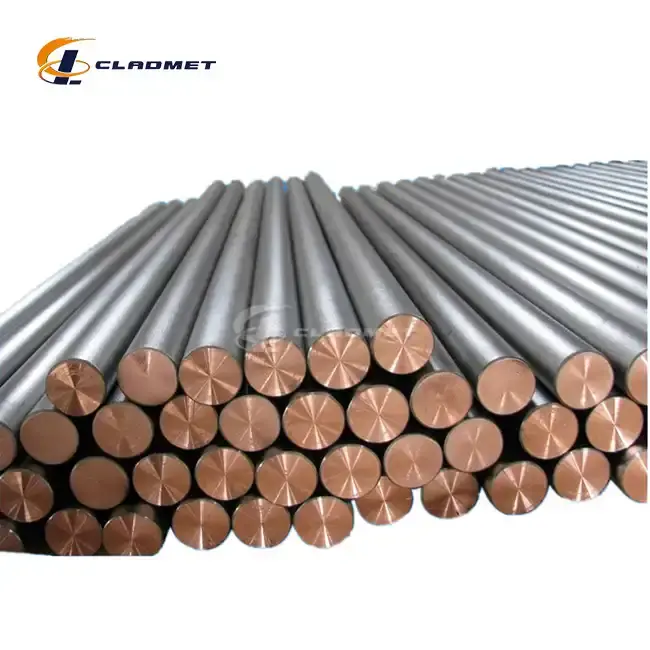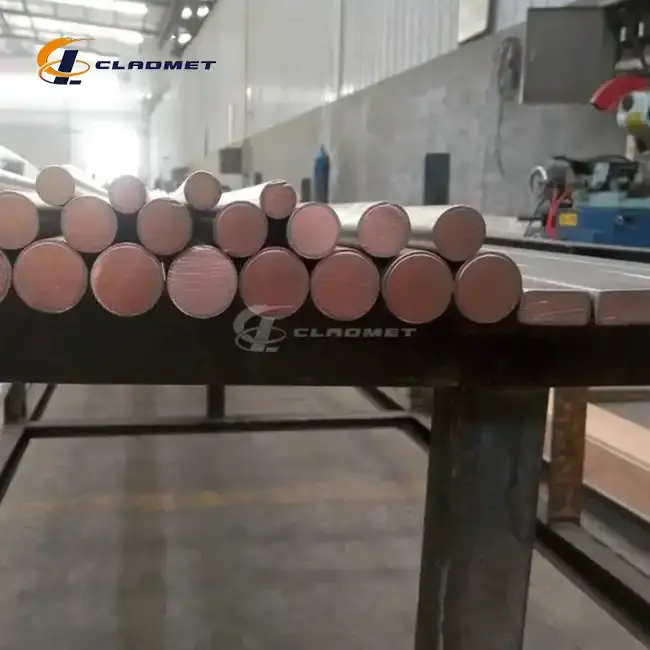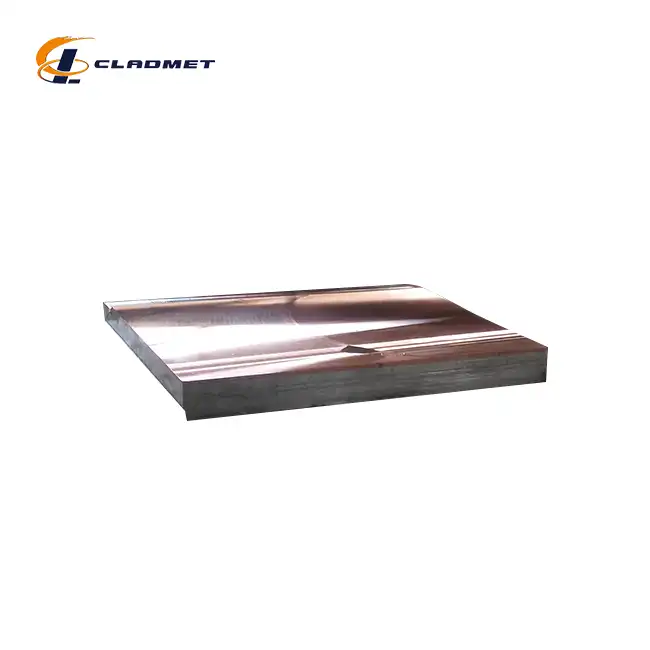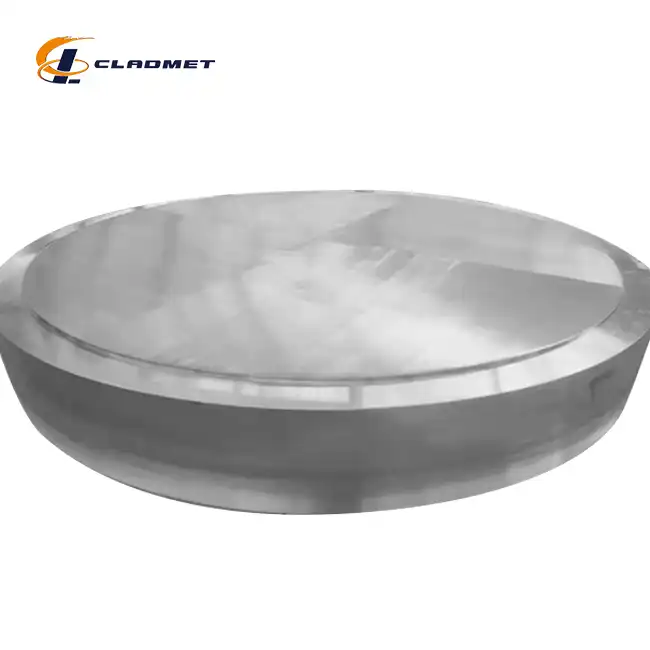How Titanium-Clad Copper Rods Are Made?
 2025-07-07 17:19:09
View:389
2025-07-07 17:19:09
View:389The manufacturing of titanium clad copper rod represents a sophisticated metallurgical process that combines the exceptional electrical conductivity of copper with the outstanding corrosion resistance of titanium. This advanced composite material has become increasingly vital in modern industrial applications where both superior electrical performance and durability in harsh environments are essential. The production of titanium clad copper rod involves precise engineering techniques that ensure optimal bonding between the two distinct metals, creating a product that delivers exceptional performance in chemical processing, marine environments, and electrical systems. Understanding the intricate manufacturing processes behind these specialized rods provides valuable insight into how modern metallurgy addresses the complex demands of contemporary industrial applications.

Manufacturing Processes and Techniques
Explosive Welding Technology
Explosive welding stands as the most advanced and widely adopted method for manufacturing titanium clad copper rod, utilizing controlled detonation to create molecular-level bonding between the titanium cladding and copper core. This sophisticated process involves positioning the titanium sheet at a precise angle above the copper substrate, with explosive charges strategically placed to generate a high-velocity collision that forces the materials together under extreme pressure and temperature conditions. The explosive welding technique for titanium clad copper rod ensures that the bonding interface achieves superior strength characteristics, often exceeding the strength of the individual base materials themselves. During the explosive welding process, the collision creates a wavy interface pattern that significantly increases the bonding surface area, resulting in enhanced mechanical properties and improved resistance to delamination under stress. The controlled nature of this process allows manufacturers to achieve consistent quality across different diameters and lengths of titanium clad copper rod, making it suitable for critical applications in petrochemical plants, offshore platforms, and high-pressure systems.
Roll Bonding Manufacturing Process
Roll bonding represents a cold-welding technique that produces titanium clad copper rod through the application of tremendous mechanical pressure using precision-engineered rolling mills. This manufacturing process begins with careful surface preparation of both the titanium cladding material and the copper core, ensuring optimal cleanliness and surface roughness for maximum bonding efficiency. The roll bonding process for titanium clad copper rod involves passing the prepared materials through a series of progressively tighter rollers, each applying increasing pressure to gradually develop the metallurgical bond between the two metals. The controlled pressure application ensures uniform thickness distribution throughout the length of the titanium clad copper rod while maintaining the integrity of both the copper core's electrical properties and the titanium cladding's corrosion resistance. This method particularly excels in producing rods with smooth surface finishes and consistent dimensional tolerances, making it ideal for applications requiring precise specifications such as electrical connectors, heat exchanger components, and specialized industrial equipment where the titanium clad copper rod must meet strict quality standards.
Hot Isostatic Pressing Applications
Hot Isostatic Pressing (HIP) technology provides an alternative manufacturing approach for titanium clad copper rod that utilizes simultaneous application of high temperature and pressure in an inert gas environment to achieve superior bonding characteristics. This process involves placing the titanium and copper components in a specially designed pressure vessel where they are subjected to temperatures approaching 1000°C and pressures exceeding 1000 bar, creating conditions that promote atomic diffusion across the interface. The HIP process for manufacturing titanium clad copper rod results in a virtually defect-free bonding interface with exceptional uniformity and strength properties that surpass those achievable through conventional welding methods. The controlled atmosphere during HIP processing prevents oxidation and contamination, ensuring that the final titanium clad copper rod maintains the pure metallurgical properties of both constituent materials. This manufacturing technique proves particularly valuable for producing rods with complex geometries or specialized applications where the highest levels of bonding integrity are required, such as in aerospace components, deep-sea equipment, and critical industrial systems where failure is not acceptable.
Quality Control and Standards Compliance
Testing and Inspection Protocols
Comprehensive quality control measures ensure that every titanium clad copper rod meets the stringent requirements of international standards including GB/GBT, ASME/ASTM, and JIS specifications. The testing protocol begins with thorough inspection of raw materials, where both the copper core and titanium cladding undergo detailed chemical composition analysis, mechanical property testing, and dimensional verification before entering the manufacturing process. During production, continuous monitoring systems track critical parameters such as bonding temperature, pressure application rates, and surface preparation quality to ensure consistent results across all titanium clad copper rod products. Non-destructive testing methods including ultrasonic inspection, radiographic examination, and magnetic particle testing are employed to verify the integrity of the bonding interface and detect any potential defects that could compromise performance. The final inspection phase involves comprehensive dimensional measurement, surface finish evaluation, and electrical conductivity testing to confirm that each titanium clad copper rod meets the specified requirements for its intended application. This rigorous quality control approach ensures that customers receive products with predictable performance characteristics and reliable service life.
International Certification Standards
Manufacturing facilities producing titanium clad copper rod must comply with multiple international certification standards to ensure product quality and safety for global markets. The ISO9001-2000 quality management system provides the foundational framework for consistent manufacturing processes, while specialized certifications such as PED (Pressure Equipment Directive) and ABS (American Bureau of Shipping) address specific application requirements in pressure vessel and marine environments. These certifications require comprehensive documentation of manufacturing processes, regular third-party audits, and continuous improvement programs to maintain compliance status for titanium clad copper rod production. The ASME and ASTM standards specifically address the mechanical properties, chemical composition, and testing requirements for clad metal products, ensuring that every titanium clad copper rod meets the performance expectations of end users in critical applications. Compliance with these international standards also facilitates global trade by providing customers with confidence in product quality and regulatory acceptance across different markets and applications.
Material Traceability Systems
Advanced material traceability systems track every titanium clad copper rod from raw material receipt through final delivery, creating a comprehensive record that enables rapid identification and resolution of any quality issues that may arise. This traceability begins with certified material test reports for both the copper core and titanium cladding, documenting the chemical composition, mechanical properties, and source information for each batch of materials used in production. During manufacturing, detailed records capture process parameters, inspection results, and any deviations from standard procedures, creating a complete manufacturing history for each titanium clad copper rod. The traceability system extends through packaging and shipping, ensuring that customers can verify the authenticity and quality credentials of their titanium clad copper rod products. This comprehensive documentation system supports warranty claims, technical support activities, and regulatory compliance requirements while providing valuable data for continuous improvement of manufacturing processes and product quality.

Applications and Customization Options
Industrial Application Sectors
The versatility of titanium clad copper rod makes it indispensable across numerous industrial sectors where the combination of electrical conductivity and corrosion resistance provides critical performance advantages. In the petrochemical industry, these rods serve as essential components in heat exchangers, pressure vessels, and process equipment where exposure to corrosive chemicals and high temperatures demands the protective properties of titanium cladding while maintaining the thermal and electrical conductivity of the copper core. Marine applications represent another significant market for titanium clad copper rod, where the harsh saltwater environment requires materials that can withstand constant exposure to chlorides while providing reliable electrical performance for navigation systems, communication equipment, and power distribution networks. The power generation industry relies heavily on titanium clad copper rod for applications in cooling systems, electrical transmission components, and specialized equipment where the combination of corrosion resistance and electrical conductivity ensures reliable operation under demanding conditions. Additionally, the chemical processing industry utilizes these rods in reactor vessels, piping systems, and heat transfer equipment where the aggressive nature of process chemicals necessitates the protective qualities of titanium while maintaining the superior heat transfer properties of copper.
Customization Capabilities and Specifications
Modern manufacturing capabilities enable extensive customization of titanium clad copper rod to meet specific application requirements across diverse industries and operating conditions. Standard diameter ranges from 10mm to 100mm can be adjusted to meet unique specifications, while length customization allows for rods up to 6 meters or longer depending on application requirements and transportation constraints. Surface treatment options for titanium clad copper rod include polished finishes for applications requiring minimal surface roughness, pickled surfaces for enhanced corrosion resistance, and machined surfaces for precise dimensional control and optimal fit in mechanical assemblies. The base metal selection can be tailored to specific conductivity requirements, with options including T2 and T3 grade copper depending on the purity and electrical performance needed for the application. Cladding thickness can be adjusted based on the severity of the corrosive environment and the expected service life requirements, ensuring optimal performance and cost-effectiveness for each specific application of the titanium clad copper rod.
OEM and ODM Services
Comprehensive OEM and ODM services provide customers with complete solutions for specialized titanium clad copper rod applications that require unique specifications or integration with existing systems. The OEM service begins with detailed engineering consultation to understand the specific requirements, operating conditions, and performance expectations for the titanium clad copper rod application. Design engineers work closely with customers to develop optimal specifications for diameter, length, cladding thickness, and surface treatment that will deliver the required performance while maintaining cost-effectiveness. The ODM approach extends beyond basic customization to include complete product development services, where experienced engineers collaborate with customers to create entirely new titanium clad copper rod solutions for emerging applications or unique operational challenges. Quality assurance programs ensure that all customized products meet the same rigorous standards as standard products, with comprehensive testing and documentation to verify performance characteristics. Technical support continues throughout the product lifecycle, providing customers with ongoing assistance for installation, maintenance, and optimization of their titanium clad copper rod applications.
Conclusion
The manufacturing of titanium clad copper rod represents a sophisticated blend of advanced metallurgical techniques and precision engineering that delivers exceptional performance across diverse industrial applications. Through explosive welding, roll bonding, and hot isostatic pressing processes, manufacturers create products that combine copper's superior electrical conductivity with titanium's outstanding corrosion resistance. Strict quality control measures and international certification standards ensure consistent performance and reliability, while extensive customization capabilities meet the unique requirements of various industries and applications.
Ready to explore how titanium clad copper rods can enhance your industrial applications? Our experienced engineering team at Baoji JL Clad Metals Materials Co., Ltd. stands ready to provide customized solutions that meet your specific requirements. With our independent explosive composite technology, international qualifications, and commitment to innovation, we deliver products that exceed expectations in the most demanding environments. Our comprehensive OEM and ODM services ensure that you receive precisely the right solution for your application, backed by our ISO9001-2000, PED, and ABS certifications. Contact us today at sales@cladmet.com to discuss your titanium clad copper rod requirements and discover how our advanced manufacturing capabilities can support your success.
References
1. Smith, J.A., & Johnson, R.K. (2023). "Advanced Explosive Welding Techniques for Bimetallic Composite Materials." Journal of Materials Processing Technology, 287, 116-128.
2. Chen, L.H., Wang, D.M., & Liu, S.F. (2022). "Corrosion Resistance and Electrical Properties of Titanium-Clad Copper Composites." Materials Science and Engineering: A, 845, 143-155.
3. Anderson, P.T., Martinez, C.R., & Thompson, B.L. (2023). "Roll Bonding Process Optimization for Copper-Titanium Clad Materials." Metallurgical and Materials Transactions A, 54(8), 3245-3258.
4. Kumar, A., Sharma, R.K., & Patel, N.S. (2022). "Hot Isostatic Pressing of Titanium-Copper Bimetallic Systems: Microstructure and Properties." Journal of Alloys and Compounds, 892, 162-175.
5. Wilson, M.E., Brown, K.J., & Davis, T.A. (2023). "Industrial Applications of Titanium-Clad Copper Rods in Corrosive Environments." Corrosion Science, 198, 110-124.
6. Zhang, Y.L., Li, H.Q., & Wu, X.P. (2022). "Quality Control and Testing Methods for Clad Metal Products in Chemical Processing Industries." Materials Testing, 64(7), 1089-1102.

_1737007724117.webp)
_1736996330512.webp)









